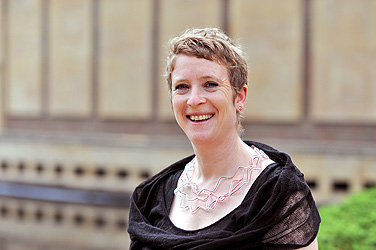Close Up
Historic analysis of ‘habitat’ is focus
of Hadas Steiner’s work

Hadas Steiner is at work on her second book, “Habitat and Home: A Study in Coevolution,” with the support of a fellowship from UB’s Humanities Institute. She is pictured here at Kleinhans Music Hall, which she says is one of her favorite spots in Buffalo. Photo: NANCY J. PARISI
-
 Print
Print -
 Comments
Comments
-
“My own research tends to be focused on practices which imagine there is potential for technology, trying to understand the direction of technology in a period of change.”
Even before Hadas Steiner arrived at UB 11 years ago, she had a natural affinity for the university through her interest in the figures of Reyner Banham, architectural critic and writer who taught at UB, and John McHale, groundbreaking artist whose papers were donated to the university by his wife Magda, a UB faculty member.
“There was a legacy of particularly eccentric thinkers in my field who for various reasons had a connection to Buffalo,” the associate professor in UB’s School of Architecture and Planning explains. “I’ve had a lot of intellectual freedom here and a real opportunity to develop both my teaching and my own course of research.”
Steiner’s interests are driven by the cross-pollinations of technology and culture in postwar architectural fabrication. “My own research tends to be focused on practices which imagine there is potential for technology, trying to understand the direction of technology in a period of change,” she says.
Her first book, “Beyond Archigram: the Structure of Circulation,” focused on the London-based 1960s underground journal published by six architects that foretold some outcomes of digital technology for architecture. “This was a group that built nothing and even as individuals little, but the ideas they depicted were hugely influential, thanks to the incredibly provocative imagery that was the product of a desire to investigate what nonmaterial technology would mean for architecture.”
Steiner is writing a manuscript that revisits Banham’s “A Concrete Atlantis,” a favorite book of hers since her PhD studies in history, theory and criticism of architecture at the Massachusetts Institute of Technology, which looked at industrial architecture through the eyes of the Buffalo landscape. “I’m looking at the way he constructed arguments using visual imagery, specifically photography, to write a revisionist history of modernism through the exemplar of Buffalo’s utilitarian architecture,” she points out.
She also is at work on her second book, “Habitat and Home: A Study in Coevolution,” with the support of a fellowship from UB’s Humanities Institute, the first recipient from the School of Architecture and Planning.
A focus of the book is on idiosyncratic figures considered to be avant garde in the ‘50s, ‘60s and ‘70s who challenged mainstream architectural modernism through the reconception of the notion of habitat in a postwar period of acute mass housing shortages. “Habitat became almost like a battle cry for the way in which the ideological altercations between the younger and older generations took on the problem,” she relates.
The book also reflects the research she conducted as a visiting fellow at the London Zoological Society and, as she describes, how animal habitats became an odd flashpoint for architectural debates. “I became interested in nonhuman habitats in which the design of an ecology was pointed.” In particular, she explores how the zoological architecture of Cedric Price and his engagement with cybernetics as an ecological model accompanied the shift toward the ethological understanding of communities.
Finally, the book incorporates the work of John McHale, who as a student of Buckminster Fuller, wrote specifically about ecology and systems design for minimum existence—conditions that took over from cybernetic investigations. “I’m particularly looking at engineers taking on the problem of designing for places that are inhospitable to human life, having to create an ecological model within a container, in space or underwater.”
The New York City native can’t put her finger on what prompted her architectural interest. It wasn’t a field that ran in her family. “My parents are not very design oriented. My father is a philosopher and he follows that model aesthetically.”
Steiner does recall that she always has been highly susceptible to environmental conditions. “My mood and the way I feel in a space has always been something I’ve been very aware of. It’s something I got from my childhood, but why I’m like that, I don’t know.”
She says her teaching at UB has been rewarding in a different way from her past teaching. “How do you bring to students an understanding of the world that’s not just providing them with a list of a series of buildings that one should know, but enable an understanding themselves of a larger project that keeps on going, that they are themselves part of an ecology,” she says.
Outside of her New York City upbringing, her stay in Buffalo represents one of the longest periods she has lived anywhere. Steiner resides in the Elmwood Village area with her daughter, Olive, 3, a pupil at Bennett Park Montessori School.
Steiner wonders why so many people tend to be fixated on the growth of a city, as opposed to what happens when a city shrinks. “It doesn’t necessarily have to mean blight. It means you have to think in different scales and different opportunities. Not everything is a preservation issue—some things are preservation issues, some are visionary issues,” she reasons. “All the people who I focus on in my historical research are visionary thinkers, so I guess Buffalo fits right in.”

Reader Comments